Challenges in Kinetic Parameter Determination for Wheat Straw Pyrolysis
Abstract
Highlights
- Second-derivative (DDTG) curves helped overcome the challenges of overlapping peaks in the DTG curves of wheat straw;
- Deconvolution methods lead to high errors in the estimation of lignin content;
- Curve-fitting methods lead to lower errors when determining the kinetics of biomass degradation, especially for hemicellulose;
- Reaction networks were modified to consider K content to describe straw pyrolysis.
Abstract
1. Introduction
2. Materials and Methods
2.1. Analytic Methods
2.2. Thermogravimetry
2.3. Data Analysis
2.4. Simulation of Mass Loss Curves
3. Results and Discussion
3.1. Estimation of the Lignocellulosic Composition
3.2. Comparison of Estimated Kinetic Results
3.3. Performance of Published Reaction Networks
Influence of Potassium Content on the Pyrolysis of Cellulose
4. Conclusions
Supplementary Materials
Author Contributions
Funding
Acknowledgments
Conflicts of Interest
References
- Anca-Couce, A.; Berger, A.; Zobel, N. How to determine consistent biomass pyrolysis kinetics in a parallel reaction scheme. Fuel 2014, 123, 230–240. [Google Scholar] [CrossRef]
- Humbird, D.; Trendewicz, A.; Braun, R.; Dutta, A. One-Dimensional Biomass Fast Pyrolysis Model with Reaction Kinetics Integrated in an Aspen Plus Biorefinery Process Model. ACS Sustain. Chem. Eng. 2017, 5, 2463–2470. [Google Scholar] [CrossRef]
- White, J.E.; Catallo, W.J.; Legendre, B.L. Biomass pyrolysis kinetics: A comparative critical review with relevant agricultural residue case studies. J. Anal. Appl. Pyrolysis 2011, 91, 1–33. [Google Scholar] [CrossRef]
- Anca-Couce, A.; Tsekos, C.; Retschitzegger, S.; Zimbardi, F.; Funke, A.; Banks, S.; Kraia, T.; Marques, P.; Scharler, R.; de Jong, W.; et al. Biomass pyrolysis TGA assessment with an international round robin. Fuel 2020, 276, 118002. [Google Scholar] [CrossRef]
- Cai, J.; Xu, D.; Dong, Z.; Yu, X.; Yang, Y.; Banks, S.W.; Bridgwater, A.V. Processing thermogravimetric analysis data for isoconversional kinetic analysis of lignocellulosic biomass pyrolysis: Case study of corn stalk. Renew. Sustain. Energy Rev. 2018, 82, 2705–2715. [Google Scholar] [CrossRef]
- Espenson, J. Chemical Kinetics and Reaction Mechanisms, 2nd ed.; McGraw-Hill: New York, NY, USA, 1995; ISBN 9780070202603. [Google Scholar]
- Wu, W.; Mei, Y.; Zhang, L.; Liu, R.; Cai, J. Kinetics and reaction chemistry of pyrolysis and combustion of tobacco waste. Fuel 2015, 156, 71–80. [Google Scholar] [CrossRef]
- Sher, F.; Iqbal, S.Z.; Liu, H.; Imran, M.; Snape, C.E. Thermal and kinetic analysis of diverse biomass fuels under different reaction environment: A way forward to renewable energy sources. Energy Convers. Manag. 2020, 203, 112266. [Google Scholar] [CrossRef]
- Manić, N.; Jankovic, B.; Stojiljkovic, D.; Jovanovic, V.; Radojevic, M. TGA-DSC-MS analysis of pyrolysis process of various agricultural residues. Therm. Sci. 2019, 23, 1457–1472. [Google Scholar] [CrossRef]
- Šimkovic, I.; Csomorová, K. Thermogravimetric analysis of agricultural residues: Oxygen effect and environmental impact. J. Appl. Polym. Sci. 2006, 100, 1318–1322. [Google Scholar] [CrossRef]
- Gaitán-Álvarez, J.; Moya, R.; Puente-Urbina, A.; Rodriguez-Zúñiga, A. Thermogravimetric, devolatilization rate, and differential scanning calorimetry analyses of biomass of tropical plantation species of Costa Rica torrefied at different temperatures and times. Energies 2018, 11, 696. [Google Scholar] [CrossRef]
- Ranzi, E.; Cuoci, A.; Faravelli, T.; Frassoldati, A.; Migliavacca, G.; Pierucci, S.; Sommariva, S. Chemical Kinetics of Biomass Pyrolysis. Energ. Fuel 2008, 22, 4292–4300. [Google Scholar] [CrossRef]
- Anca-Couce, A.; Scharler, R. Modelling heat of reaction in biomass pyrolysis with detailed reaction schemes. Fuel 2017, 206, 572–579. [Google Scholar] [CrossRef]
- Faravelli, T.; Frassoldati, A.; Migliavacca, G.; Ranzi, E. Detailed kinetic modeling of the thermal degradation of lignins. Biomass Bioenergy 2010, 34, 290–301. [Google Scholar] [CrossRef]
- Di Blasi, C. Modeling chemical and physical processes of wood and biomass pyrolysis. Prog. Energy Combust. Sci. 2008, 34, 47–90. [Google Scholar] [CrossRef]
- Yang, H.; Yan, R.; Chen, H.; Lee, D.H.; Zheng, C. Characteristics of hemicellulose, cellulose and lignin pyrolysis. Fuel 2007, 86, 1781–1788. [Google Scholar] [CrossRef]
- Manyà, J.J.; Velo, E.; Puigjaner, L. Kinetics of biomass pyrolysis: A reformulated three-parallel-reactions model. Ind. Eng. Chem. Res. 2003, 42, 434–441. [Google Scholar] [CrossRef]
- Gomez Diaz, C.J. Understanding Biomass Pyrolysis Kinetics: Improved Modeling Based on Comprehensive Thermokinetic Analysis; Universitat Politècnica de Catalunya: Barcelona, Spain, 2006. [Google Scholar]
- Gómez, C.J.; Várhegyi, G.; Puigjaner, L. Slow pyrolysis of woody residues and an herbaceous biomass crop: A kinetic study. Ind. Eng. Chem. Res. 2005, 44, 6650–6660. [Google Scholar] [CrossRef]
- Corbetta, M.; Pierucci, S.; Ranzi, E.; Bennadji, H.; Fisher, E.M. Multistep Kinetic Model of Biomass Pyrolysis. In Proceedings of the XXXVI Meeting of the Italian Section of the Combustion Institute, Procida, Italy, 13–15 June 2013; pp. 4–9. [Google Scholar]
- Ranzi, E.; Debiagi, P.E.A.; Frassoldati, A. Mathematical Modeling of Fast Biomass Pyrolysis and Bio-Oil Formation. Note I: Kinetic Mechanism of Biomass Pyrolysis. ACS Sustain. Chem. Eng. 2017, 5, 2867–2881. [Google Scholar] [CrossRef]
- Ranzi, E.; Debiagi, P.E.A.; Frassoldati, A. Mathematical Modeling of Fast Biomass Pyrolysis and Bio-Oil Formation. Note II: Secondary Gas-Phase Reactions and Bio-Oil Formation. ACS Sustain. Chem. Eng. 2017, 5, 2882–2896. [Google Scholar] [CrossRef]
- Debiagi, P.; Gentile, G.; Cuoci, A.; Frassoldati, A.; Ranzi, E.; Faravelli, T. A predictive model of biochar formation and characterization. J. Anal. Appl. Pyrolysis 2018, 134, 326–335. [Google Scholar] [CrossRef]
- Pecha, M.B.; Arbelaez, J.I.M.; Garcia-Perez, M.; Chejne, F.; Ciesielski, P.N. Progress in understanding the four dominant intra-particle phenomena of lignocellulose pyrolysis: Chemical reactions, heat transfer, mass transfer, and phase change. Green Chem. 2019, 21, 2868–2898. [Google Scholar] [CrossRef]
- Fonseca, F.G.; Funke, A.; Niebel, A.; Soares Dias, A.P.; Dahmen, N. Moisture content as a design and operational parameter for fast pyrolysis. J. Anal. Appl. Pyrolysis 2019, 139, 73–86. [Google Scholar] [CrossRef]
- Trendewicz, A.; Evans, R.; Dutta, A.; Sykes, R.; Carpenter, D.; Braun, R. Evaluating the effect of potassium on cellulose pyrolysis reaction kinetics. Biomass Bioenergy 2015, 74, 15–25. [Google Scholar] [CrossRef]
- Marcilla, A.; García, A.N.; Pastor, M.V.; León, M.; Sánchez, A.J.; Gómez, D.M. Thermal decomposition of the different particles size fractions of almond shells and olive stones. Thermal behaviour changes due to the milling processes. Thermochim. Acta 2013, 564, 24–33. [Google Scholar] [CrossRef]
- Scott, D.S.; Piskorz, J. The flash pyrolysis of aspen-poplar wood. Can. J. Chem. Eng. 1982, 60, 666–674. [Google Scholar] [CrossRef]
- Bridgwater, A.V.V. Review of fast pyrolysis of biomass and product upgrading. Biomass Bioenergy 2012, 38, 68–94. [Google Scholar] [CrossRef]
- Wang, X.; Kersten, S.R.A.; Prins, W.; Van Swaaij, W.P.M. Biomass pyrolysis in a fluidized bed reactor. Part 2: Experimental validation of model results. Ind. Eng. Chem. Res. 2005, 44, 8786–8795. [Google Scholar] [CrossRef]
- Shen, J.; Wang, X.-S.; Garcia-Perez, M.; Mourant, D.; Rhodes, M.J.; Li, C.-Z. Effects of particle size on the fast pyrolysis of oil mallee woody biomass. Fuel 2009, 88, 1810–1817. [Google Scholar] [CrossRef]
- Salehi, E.; Abedi, J.; Harding, T. Bio-oil from Sawdust: Effect of Operating Parameters on the Yield and Quality of Pyrolysis Products. Energy Fuels 2011, 25, 4145–4154. [Google Scholar] [CrossRef]
- Demirbas, A. Effects of temperature and particle size on bio-char yield from pyrolysis of agricultural residues. J. Anal. Appl. Pyrolysis 2004, 72, 243–248. [Google Scholar] [CrossRef]
- Luangkiattikhun, P.; Tangsathitkulchai, C.; Tangsathitkulchai, M. Non-isothermal thermogravimetric analysis of oil-palm solid wastes. Bioresour. Technol. 2008, 99, 986–997. [Google Scholar] [CrossRef] [PubMed]
- Pütün, A.E.; Koçkar, Ö.M.; Yorgun, S.; Gerçel, H.F.; Andresen, J.; Snape, C.E.; Pütün, E. Fixed-bed pyrolysis and hydropyrolysis of sunflower bagasse: Product yields and compositions. Fuel Process. Technol. 1996, 46, 49–62. [Google Scholar] [CrossRef]
- López Ordovás, J. Construction of a Model for the Design of a Rotary Kiln For Slow Pyrolysis of Biomass—Greencarbon Project; Aston University: Birmingham, UK, 2020. [Google Scholar]
- Cai, J.M.; Bi, L.S. Kinetic analysis of wheat straw pyrolysis using isoconversional methods. J. Therm. Anal. Calorim. 2009, 98, 325–330. [Google Scholar] [CrossRef]
- Yang, Q.; Wu, S. Wheat straw pyrolysis analysis by thermogravimetry and gas chromatography-mass spectrometry. Cellul. Chem. Technol. 2009, 43, 123–131. [Google Scholar] [CrossRef]
- Zhaosheng, Y.; Xiaoqian, M.; Ao, L. Kinetic studies on catalytic combustion of rice and wheat straw under air- and oxygen-enriched atmospheres, by using thermogravimetric analysis. Biomass Bioenergy 2008, 32, 1046–1055. [Google Scholar] [CrossRef]
- Rong, H.; Yuan, J.; Feng, Y.; Yi, Y.; Chang, Z. A TG-IR study on the co-pyrolysis characteristics of oily sludge and crops. Biomass Convers. Biorefinery 2020. [Google Scholar] [CrossRef]
- Naqvi, S.R.; Ali, I.; Nasir, S.; Ali Ammar Taqvi, S.; Atabani, A.E.; Chen, W.-H. Assessment of agro-industrial residues for bioenergy potential by investigating thermo-kinetic behavior in a slow pyrolysis process. Fuel 2020, 278, 118259. [Google Scholar] [CrossRef]
- Luo, L.; Guo, X.; Zhang, Z.; Chai, M.; Rahman, M.M.; Zhang, X.; Cai, J. Insight into Pyrolysis Kinetics of Lignocellulosic Biomass: Isoconversional Kinetic Analysis by the Modified Friedman Method. Energy Fuels 2020, 34, 4874–4881. [Google Scholar] [CrossRef]
- Wu, J.; Liao, Y.; Lin, Y.; Tian, Y.; Ma, X. Study on thermal decomposition kinetics model of sewage sludge and wheat based on multi distributed activation energy. Energy 2019, 185, 795–803. [Google Scholar] [CrossRef]
- Mureddu, M.; Dessì, F.; Orsini, A.; Ferrara, F.; Pettinau, A. Air- and oxygen-blown characterization of coal and biomass by thermogravimetric analysis. Fuel 2018, 212, 626–637. [Google Scholar] [CrossRef]
- Peng, Y.; Wu, S. The structural and thermal characteristics of wheat straw hemicellulose. J. Anal. Appl. Pyrolysis 2010, 88, 134–139. [Google Scholar] [CrossRef]
- Yang, Q.; Wu, S.; Lou, R.; Lv, G. Analysis of wheat straw lignin by thermogravimetry and pyrolysis-gas chromatography/mass spectrometry. J. Anal. Appl. Pyrolysis 2010, 87, 65–69. [Google Scholar] [CrossRef]
- Yew, A.C. Numerical Differentiation: Finite Differences; Brown University: Providence, RI, USA, 2011. [Google Scholar]
- Rego, F.; Dias, A.P.S.; Casquilho, M.; Rosa, F.C.; Rodrigues, A. Fast determination of lignocellulosic composition of poplar biomass by Thermogravimetry. Biomass Bioenergy 2019, 122, 375–380. [Google Scholar] [CrossRef]
- Şen, A.U.; Fonseca, F.G.; Funke, A.; Pereira, H.; Lemos, F. Pyrolysis kinetics and estimation of chemical composition of Quercus cerris cork. Biomass Convers. Biorefinery 2020. [Google Scholar] [CrossRef]
- Carrier, M.; Auret, L.; Bridgwater, A.; Knoetze, J.H. Using apparent activation energy as a reactivity criterion for biomass pyrolysis. Energy Fuels 2016, 30, 7834–7841. [Google Scholar] [CrossRef]
- Vyazovkin, S.; Burnham, A.K.; Criado, J.M.; Pérez-Maqueda, L.A.; Popescu, C.; Sbirrazzuoli, N. ICTAC Kinetics Committee recommendations for performing kinetic computations on thermal analysis data. Thermochim. Acta 2011, 520, 1–19. [Google Scholar] [CrossRef]
- Hindmarsh, A.C.; Petzold, L.R. Algorithms and software for ordinary differential equations and differential- algebraic equations, Part I: Euler methods and error estimation. Comput. Phys. 1995, 9, 34. [Google Scholar] [CrossRef][Green Version]
- Kornmayer, C. Verfahrenstechnik Untersuchungen zur Schnellpyrolyse von Lignocellulose im Doppenschnecken-Mischreaktor; Universität Fridericiana Karlsruhe: Karlsruhe, Germany, 2009. [Google Scholar]
- Zhou, H.; Long, Y.; Meng, A.; Li, Q.; Zhang, Y. The pyrolysis simulation of five biomass species by hemi-cellulose, cellulose and lignin based on thermogravimetric curves. Thermochim. Acta 2013, 566, 36–43. [Google Scholar] [CrossRef]
- Maschio, G.; Cozzani, V.; Lucchesi, A.; Stoppato, G.; Maschio, G. A New Method to Determine the Composition of Biomass by Thermogravimetric Analysis. Can. J. Chem. Eng. 1997, 75, 127–133. [Google Scholar] [CrossRef]
- Caballero, J.A.; Font, R.; Marcilla, A. Comparative study of the pyrolysis of almond shells and their fractions, holocellulose and lignin. Product yields and kinetics. Thermochim. Acta 1996, 276, 57–77. [Google Scholar] [CrossRef]
- Venkatesh, M.; Ravi, P.; Tewari, S.P. Isoconversional Kinetic Analysis of Decomposition of Nitroimidazoles: Friedman method vs. Flynn–Wall–Ozawa Method. J. Phys. Chem. A 2013, 117, 10162–10169. [Google Scholar] [CrossRef] [PubMed]
- Wang, J.; Minami, E.; Kawamoto, H. Thermal reactivity of hemicellulose and cellulose in cedar and beech wood cell walls. J. Wood Sci. 2020, 66, 41. [Google Scholar] [CrossRef]
- Peters, J.F.; Banks, S.W.; Bridgwater, A.V.; Dufour, J. A kinetic reaction model for biomass pyrolysis processes in Aspen Plus. Appl. Energy 2017, 188, 595–603. [Google Scholar] [CrossRef]

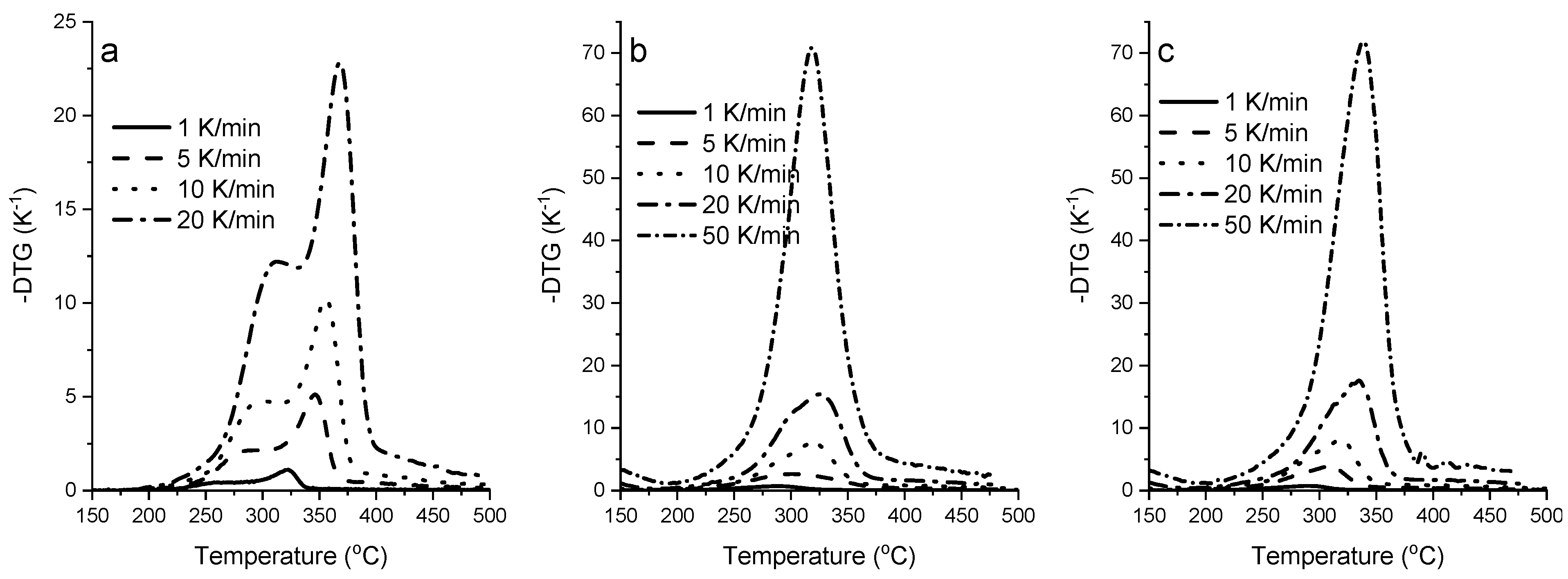
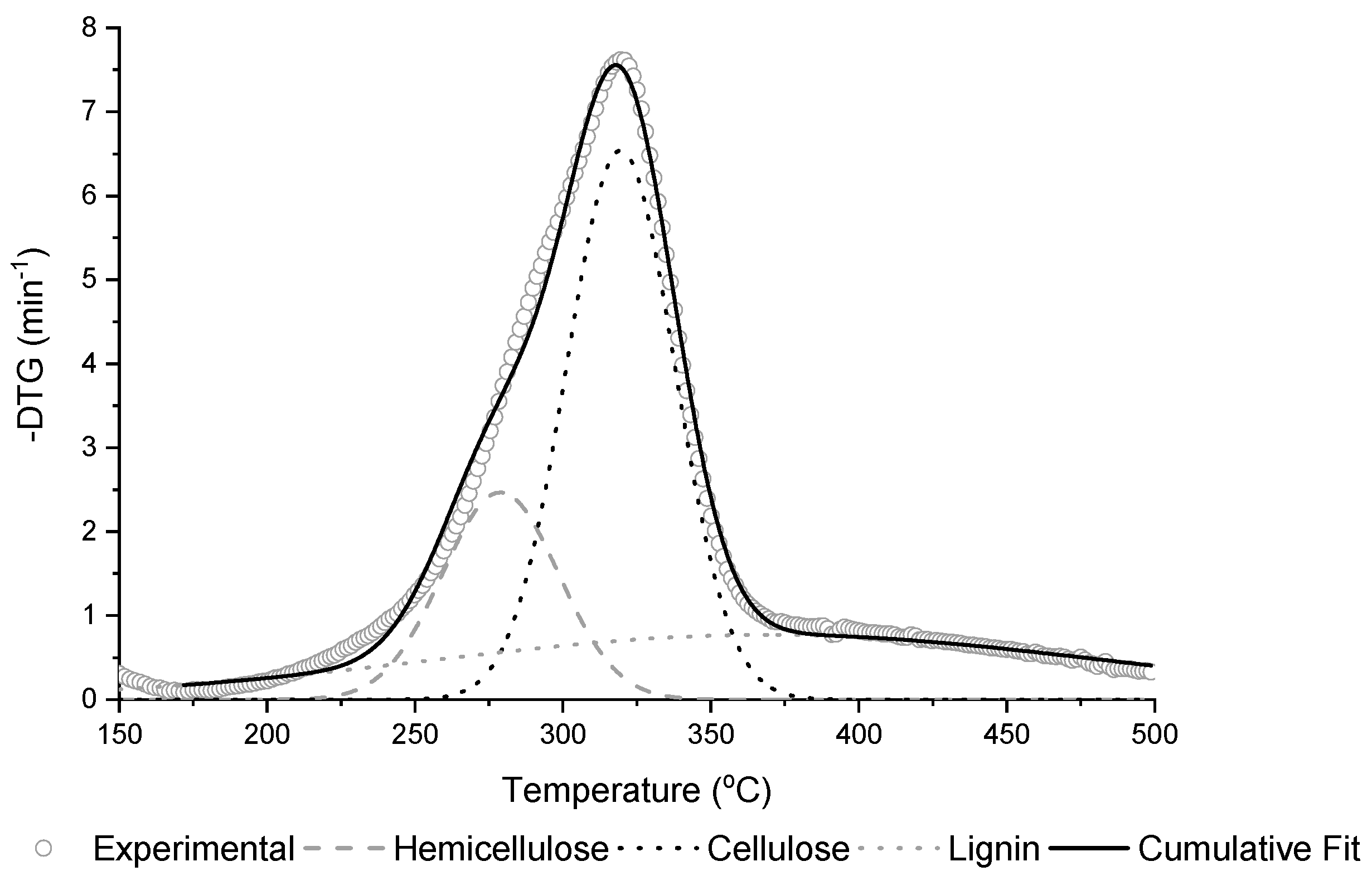
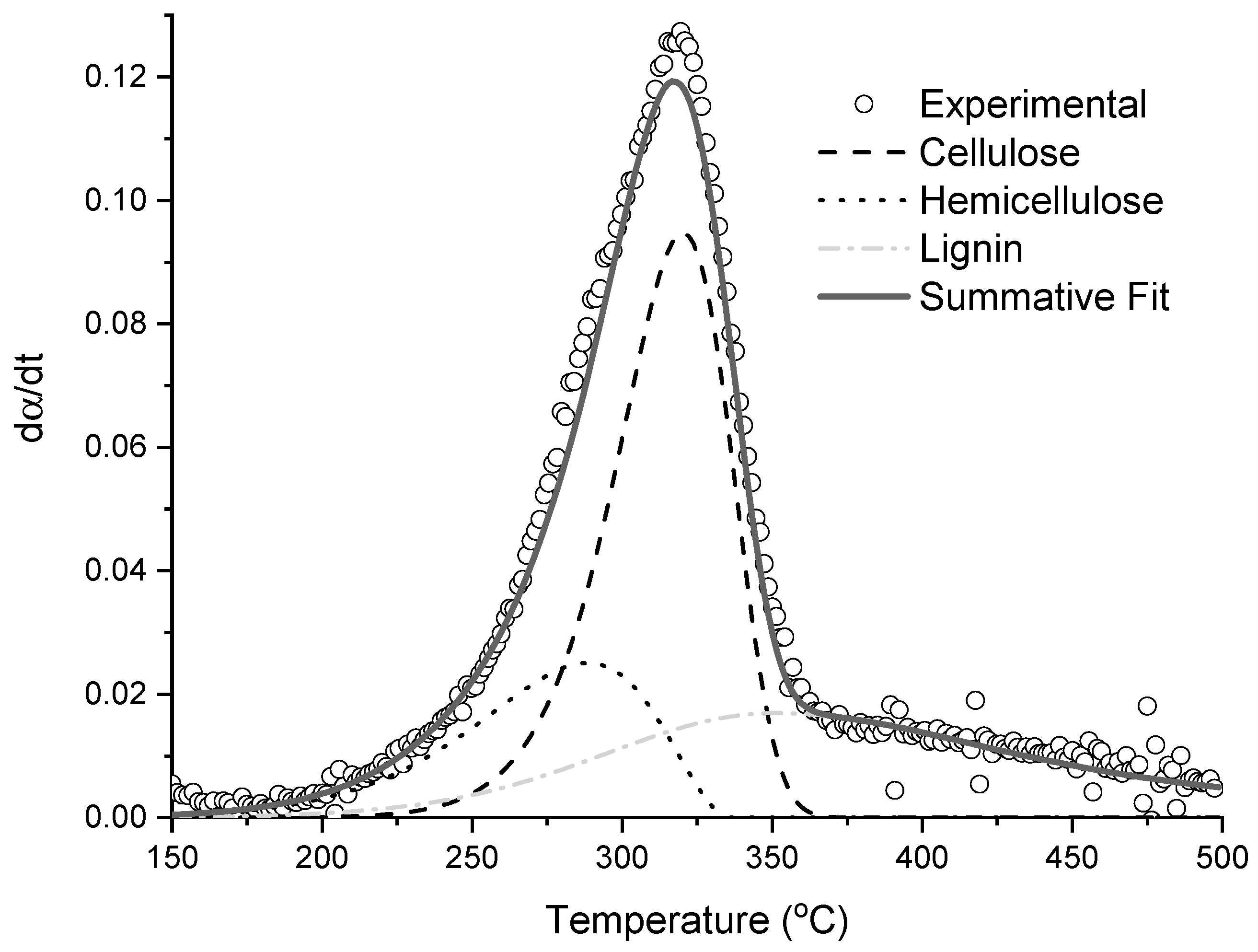
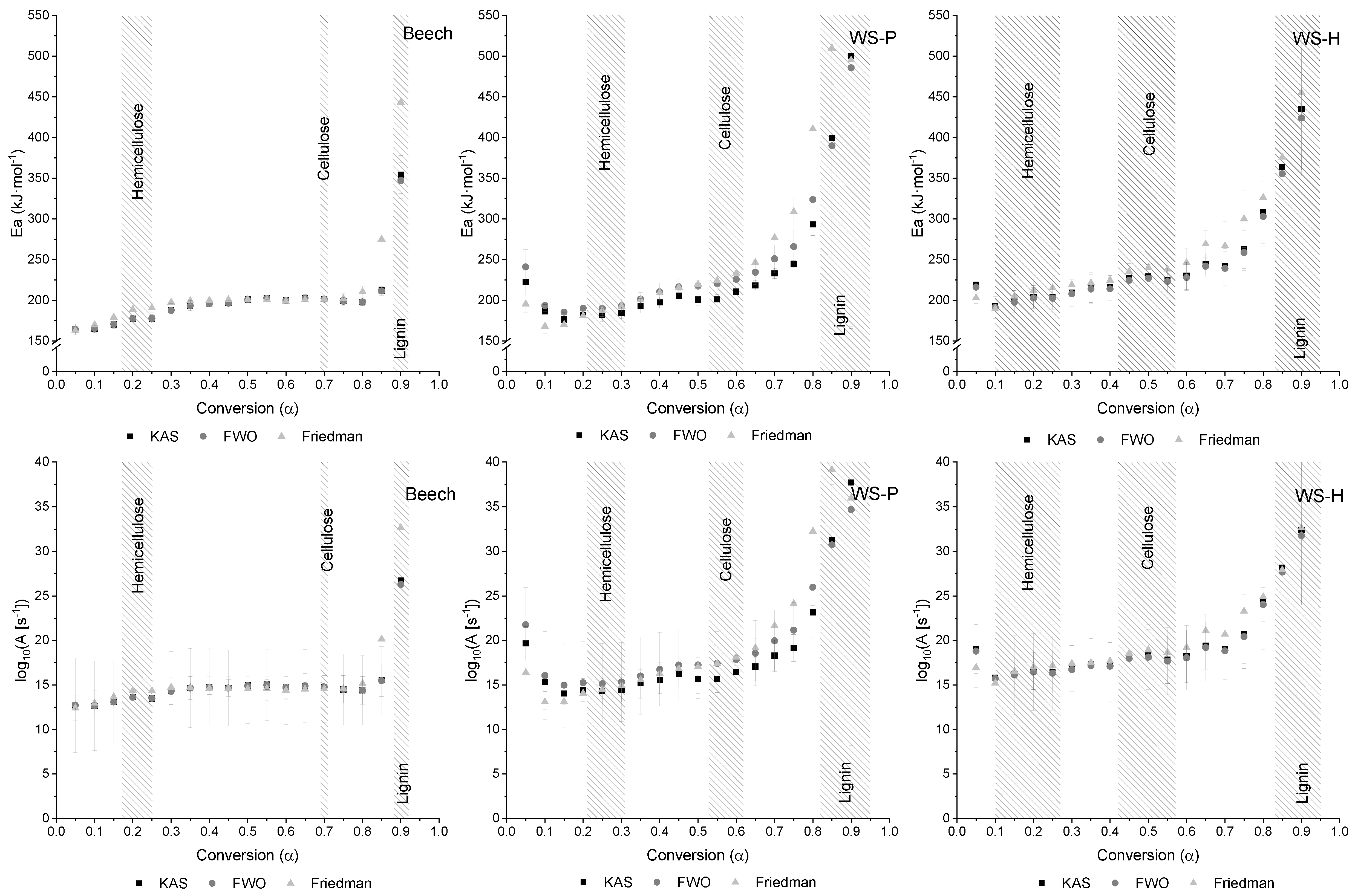
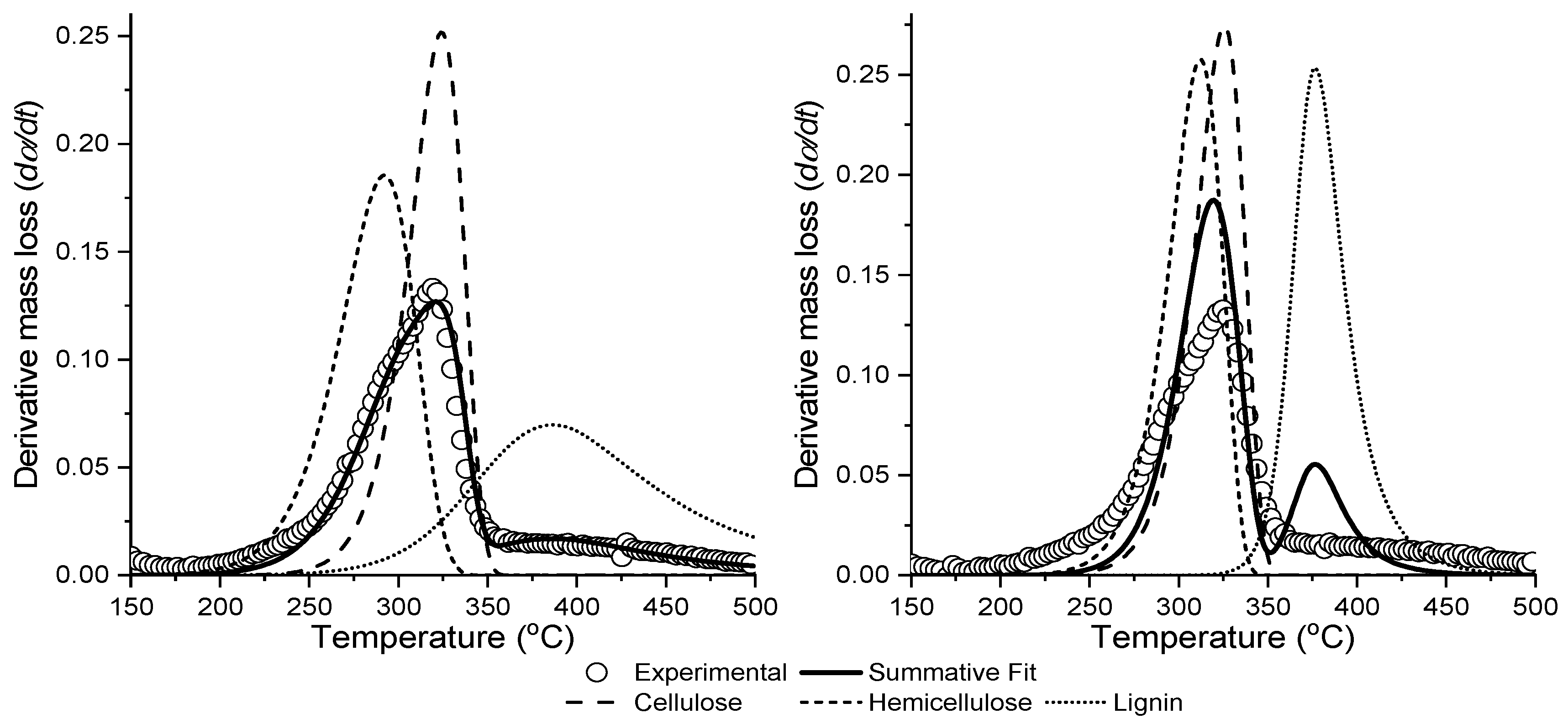


| Method | Temperature Range (°C) | Heating Rates (K·min−1) | Ea (kJ·mol−1) | log10 (A (s−1)) |
|---|---|---|---|---|
| KAS | α 0.10–0.70 a | 1, 2.5, 5 | 214–353 | 19.1–32.8 |
| FWO | α 0.10–0.70 a | 1, 2.5, 5 | 215–347 | 19.2–32.3 |
| Friedman | α 0.10–0.70 a | 1, 2.5, 5 | 218–535 | 19.7–48.4 |
| Curve Fitting | 100–900 | 1, 2.5, 5 | 226.90 | 21.03 |
| Method | Temperature Range (°C) | Heating Rates (K·min−1) | Ea (kJ·mol−1) | log10 (A (s−1)) | Reference |
|---|---|---|---|---|---|
| FWO | 315–392 | 5, 10, 20 | 130–175 | - | [37] |
| Kissinger | 220–400 | 10, 20, 30, 40, 50 | 93.92 | 3.03 | [38] |
| Coats–Redfern | 198–338 | 30 | 115.59 | 11.97 | [39] |
| Coats–Redfern | 338–840 | 30 | 24.26 | 3.42 | [39] |
| Coats–Redfern a | 220–260 | 10 | 69 | - | [10] |
| Coats–Redfern | 251–347 | 20 | 8.81 | - | [40] |
| Coats–Redfern (First Order Model) | 250–400 | 5 | 40.84 | 5.55 | [41] |
| Coats–Redfern (3D diffusion model) | 250–400 | 5 | 82.44 | 6.99 | [41] |
| Coats–Redfern (Geometric contraction) | 250–400 | 5 | 36.53 | 9.06 | [41] |
| Coats–Redfern (Avarami–Erofe’ev) | 250–400 | 5 | 15.73 | 5.53 | [41] |
| Coats–Redfern (Power Law) | 250–400 | 5 | 9.70 | 5.53 | [41] |
| Modified Friedman | α 0.05–0.60b | 2.5, 5, 10, 20 | 154–176 | - | [42] |
| Modified Friedman | α 0.60–0.85 b | 2.5, 5, 10, 20 | 176–379 | - | [42] |
| DAEM | 177–527 | 40, 45, 50 | 236–382 | 2.95 | [43] |
| Unrecognized c | 215–315 | 20 | 98.98 | - | [8] |
| Feedstock | Method | Temperature Range (°C) | Heating Rates (K·min−1) | Ea (kJ·mol−1) | log10 (A (s−1)) | Reference |
|---|---|---|---|---|---|---|
| Hemicellulose WS | Coats–Redfern | 160–350 | 5, 10, 20, 30 | 88–97 | 7.42–8.90 | [45] |
| Hemicellulose WS | Coats–Redfern | 350–550 | 5, 10, 20, 30 | 53–59 | 2.80–3.72 | [45] |
| Enzymatic Acidolysis WS Lignin | Kissinger | 343–392 | 10, 20, 30, 40, 50 | 103.92 | 3.06 | [46] |
| Enzymatic Acidolysis WS Lignin | Ozawa | 343–392 | 10, 20, 30, 40, 50 | 107.69 | 3.09 | [46] |
| Beech | WS-P | WS-H | |
|---|---|---|---|
| Moisture (wt.%) | 9.0 | 9.3 | 9.2 |
| Ash (wt.%) | 1.0 | 6.9 | 7.0 |
| Volatile Matter (wt.%) | 81.7 | 67.5 | 67.5 |
| Ultimate Analysis | |||
| C (wt.%) | 47.3 | 43.8 | 43.8 |
| H (wt.%) | 6.1 | 6.1 | 6.1 |
| N (wt.%) | <0.3 | <1 | <1 |
| S (wt.%) | 0.02 | 0.09 | 0.09 |
| Ca (ppm) | 2644 | 3780 | 3780 |
| K (ppm) | 955 | 11,800 | 11,800 |
| Si (ppm) | 6521 | 22,600 | 22,600 |
| Heating Rate (K min−1) | Beech | ||
|---|---|---|---|
| Hemicellulose | Cellulose | Lignin | |
| 1 | T = 260.6 ± 0.5 α = 0.17 ± 0.01 | T = 322.9 ± 0.1 α = 0.71 ± 0.00 | T = 344.8 ± 0.4 α = 0.88 ± 0.00 |
| 5 | T = 294.3 ± 0.9 α = 0.25 ± 0.00 | T = 345.1 ± 0.7 α = 0.69 ± 0.00 | T = 370.0 ± 1.1 α = 0.89 ± 0.00 |
| 10 | T = 299.1 ± 0.6 α = 0.22 ± 0.01 | T = 354.9 ± 0.2 α = 0.69 ± 0.00 | T = 391.3 ± 0.8 α = 0.91 ± 0.00 |
| 20 | T = 312.2 α = 0.23 | T = 368.3 α = 0.71 | T = 400.3 α = 0.92 |
| Heating Rate (K min−1) | WS-P | ||
| 1 | T = 263.3 ± 2.5 α = 0.26 ± 0.03 | T = 288.6 ± 0.5 α = 0.53 ± 0.00 | T = 330.6 ± 5.4 α = 0.82 ± 0.01 |
| 5 | T = 275.5 ± 3.4 α = 0.21 ± 0.01 | T = 310.9 ± 1.9 α = 0.57 ± 0.00 | T = 353.5 ± 2.4 α = 0.84 ± 0.00 |
| 10 | T = 283.5 ± 1.6 α = 0.21 ± 0.00 | T = 321.4 ± 1.0 α = 0.59 ± 0.00 | T = 369.6 ± 1.5 α = 0.86 ± 0.00 |
| 20 | T = 299.6 ± 0.2 α = 0.23 ± 0.00 | T = 334.6 ± 0.1 α = 0.62 ± 0.00 | T = 379.1 ± 0.2 α = 0.88 ± 0.00 |
| 50 | T = 316.6 ± 0.8 α = 0.31 ± 0.01 | T = 338.5 ± 0.2 α = 0.60 ± 0.00 | T = 393.5 ± 4.0 α = 0.92 ± 0.00 |
| Heating Rate (K min−1) | WS-H | ||
| 1 | T = 257.1 α = 0.21 | T = 287.9 α = 0.52 | T = 349.7 α = 0.86 |
| 5 | T = 256.1 α = 0.10 | T = 300.7 α = 0.42 | T = 352.3 α = 0.83 |
| 10 | T = 279.8 α = 0.17 | T = 319.5 α = 0.55 | T = 375.9 α = 0.89 |
| 20 | T = 289.9 ± 0.9 α = 0.20 ± 0.01 | T = 326.7 ± 1.4 α = 0.57 ± 0.01 | T = 400.4 ± 1.7 α = 0.92 ± 0.00 |
| 50 | T = 302.7 ± 1.9 α = 0.27 ± 0.00 | T = 321.5 ± 2.5 α = 0.51 ± 0.00 | T = 420.5 ± 3.3 α = 0.95 ± 0.00 |
| Cellulose | Hemicellulose | Lignin | ||
|---|---|---|---|---|
| Beech | Literature a | 47.9 ± 5.0 | 28.9 ± 2.5 | 23.2 ± 2.7 |
| Model-Fitting Anca-Couce b | 54.2 (13.2%) | 33.1 (14.5%) | 12.8 (−44.8%) | |
| Deconvolution | 43.8 ± 1.2 (−8.6%) | 38.0 ± 1.4 (31.5%) | 18.1 ± 1.7 (−22.0%) | |
| Model-fitting First Order | 54.7 (14.2%) | 28.2 (−2.4%) | 17.1 (−26.3%) | |
| Model-Fitting nLig = 3 | 46.9 (−2.1%) | 24.9 (−14.0%) | 28.2 (21.7%) | |
| Model-Fitting Free Order | 45.6 (−4.7%) | 19.3 (−33.1%) | 35.0 (51.0%) | |
| Wheat Straw Powder (WS-P) | Literature c | 45.5 ± 1.4 | 32.6 ± 2.5 | 21.9 ± 1.0 |
| Deconvolution | 36.4 ± 1.3 (−20.0%) | 26.4 ± 1.1 (−19.0%) | 37.2 ± 0.4 (69.9%) | |
| Model-Fitting First Order | 47.2 (3.8%) | 24.7 (−24.2%) | 28.1 (28.1%) | |
| Model-Fitting nLig = 3 | 44.3 (−2.7%) | 31.4 (−3.8%) | 24.4 (11.3%) | |
| Model-Fitting Free Order | 42.5 (−6.6%) | 32.5 (−0.3%) | 25.0 (14.2%) | |
| Wheat straw Hull (WS-H) | Literature c | 45.5 ± 1.4 | 32.6 ± 2.5 | 21.9 ± 1.0 |
| Deconvolution | 47.4 ± 1.0 (4.2%) | 18.7 ± 1.8 (−42.6%) | 33.9 ± 1.2 (54.8%) | |
| Model-Fitting First Order | 43.2 (−5.0%) | 32.1 (−1.4%) | 24.6 (12.5%) | |
| Model-Fitting nLig = 3 | 41.7 (−8.4%) | 31.7 (−2.9%) | 26.7 (21.8%) | |
| Model-Fitting Free Order | 39.0 (−14.3%) | 31.5 (−3.4%) | 29.5 (34.7%) |
| Cellulose | Hemicellulose | Lignin | Error per Method | |
|---|---|---|---|---|
| Deconvolution | 10.9% ± 7.5% | 31.0% ± 10.9% | 48.9% ± 22.6% | 30.3% ± 13.4% |
| Model-Fitting First-Order | 7.6% ± 5.3% | 9.3% ± 11.9% | 22.3% ± 7.9% | 13.1% ± 6.6% |
| Model-Fitting nLig = 3 | 4.4% ± 3.2% | 6.9% ± 5.7% | 18.2% ± 5.6% | 9.8% ± 4.9% |
| Model-Fitting Free Order | 8.5% ± 4.7% | 12.3% ± 16.7% | 33.3% ± 17.1% | 18.0% ± 10.8% |
| Error per Pseudo-Component | 7.9% ± 3.0% | 14.9% ± 8.1% | 30.7% ± 10.1% |
| Beech Wood Powder | Wheat Straw Powder | Wheat Straw Hull | ||||||||
|---|---|---|---|---|---|---|---|---|---|---|
| T Peak (°C) | Ea (kJ·mol−1) | log10 (A(s−1)) | T Peak (°C) | Ea (kJ·mol−1) | log10 (A(s−1)) | T Peak (°C) | Ea (kJ·mol−1) | log10 (A(s−1)) | ||
| Cellulose | DTG Peak | 357.3 | 318.2 | 319.4 | ||||||
| Isoconversional KAS | 355.9 | 201.4 | 14.75 | 325.5 | 206.9 | 16.12 | 323.5 | 226.6 | 17.97 | |
| Isoconversional FWO | 355.9 | 201.2 | 14.75 | 323.6 | 224.8 | 17.79 | 322.1 | 224.6 | 17.81 | |
| Isoconversional Friedman | 364.2 | 201.5 | 14.56 | 334.5 | 231.6 | 17.99 | 333.2 | 239.8 | 18.77 | |
| Model-Fitting First Order | 353.1 | 198.4 | 14.55 | 323.3 | 185.2 | 14.24 | 325.0 | 191.6 | 14.78 | |
| Model-Fitting n3 = 3 | 353.1 | 208.6 | 15.44 | 324.1 | 188.2 | 14.49 | 323.5 | 195.9 | 15.20 | |
| Model-Fitting Free Order | 354.5 | 211.0 | 15.61 | 322.8 | 190.6 | 14.74 | 322.1 | 201.4 | 15.71 | |
| KAS RR a | 199.9 | |||||||||
| Model-Fitting Free-Order RR a | 354.5 | 199.6 | 14.63 | |||||||
| Beech Wood Powder | Wheat Straw Powder | Wheat Straw Hull | |||||||||||
|---|---|---|---|---|---|---|---|---|---|---|---|---|---|
| T Peak (°C) | Ea (kJ·mol−1) | log10 (A(s−1)) | Order | T Peak (°C) | Ea (kJ·mol−1) | log10 (A(s−1)) | Order | T Peak (°C) | Ea (kJ·mol−1) | log10 (A(s−1)) | Order | ||
| Hemcellulose | DTG Peak | 298.2 | 283.2 | 279.8 | |||||||||
| Isoconversional KAS | 326.8 | 178.3 | 13.59 | 1 | 312.0 | 183.7 | 14.43 | 1 | 304.3 | 203.6 | 16.51 | 1 | |
| Isoconversional FWO | 324.0 | 178.5 | 13.61 | 1 | 309.9 | 192.2 | 15.28 | 1 | 304.3 | 202.2 | 16.39 | 1 | |
| Isoconversional Friedman | 336.4 | 190.1 | 14.34 | 1 | 320.6 | 189.1 | 14.67 | 1 | 312.5 | 211.4 | 16.95 | 1 | |
| Model-Fitting First Order | 298.9 | 136.3 | 10.41 | 1 | 289.0 | 125.5 | 9.58 | 1 | 288.8 | 147.3 | 11.68 | 1 | |
| Model-Fitting n3 = 3 | 297.5 | 139.3 | 10.72 | 1 | 292.3 | 119.8 | 8.96 | 1 | 287.4 | 147.6 | 11.72 | 1 | |
| Model-Fitting Free Order | 288.8 | 156.2 | 12.55 | 1.62 | 287.9 | 138.8 | 10.87 | 1.74 | 286.0 | 172.5 | 14.14 | 1.48 | |
| KAS RR a | 185.7 | 1 | |||||||||||
| Model-Fitting Free-Order RR a | 296.1 | 161.7 | 12.86 | 1.79 | |||||||||
| Beech Wood Powder | Wheat Straw Powder | Wheat Straw Hull | |||||||||||
|---|---|---|---|---|---|---|---|---|---|---|---|---|---|
| T Peak (°C) | Ea (kJ·mol−1) | log10 (A(s−1)) | Order | T Peak (°C) | Ea (kJ·mol−1) | log10 (A(s−1)) | Order | T Peak (°C) | Ea (kJ·mol−1) | log10 (A(s−1)) | Order | ||
| Lignin | DTG Peak | 390.2 | 366.7 | 369.5 | |||||||||
| Isoconversional KAS | 390.5 | 423.9 | 31.65 | 1 | 377.1 | 434.2 | 33.20 | 1 | 375.5 | 387.5 | 29.49 | 1 | |
| 389.2 | 3 | 376.3 | 3 | 374.1 | 3 | ||||||||
| Isoconversional FWO | 390.5 | 413.2 | 30.82 | 1 | 387.4 | 430.0 | 32.31 | 1 | 371.2 | 378.5 | 28.97 | 1 | |
| 389.2 | 3 | 386.1 | 3 | 369.9 | 3 | ||||||||
| Isoconversional Friedman | 408.8 | 508.3 | 37.26 | 1 | 394.4 | 506.8 | 38.00 | 1 | 400.7 | 404.0 | 29.58 | 1 | |
| 408.8 | 3 | 394.2 | 3 | 399.3 | 3 | ||||||||
| Model-Fitting First Order | 444.2 | 58.2 | 1.60 | 1 | 421.4 | 54.4 | 1.45 | 1 | 411.7 | 69.7 | 2.79 | 1 | |
| Model-Fitting n3 = 3 | 351.8 | 105.0 | 6.43 | 3 | 386.1 | 119.9 | 7.20 | 3 | 369.9 | 126.0 | 7.96 | 3 | |
| Model-Fitting Free Order | 304.7 | 222.6 | 18.09 | 7.73 | 376.6 | 160.5 | 10.71 | 4.93 | 356.2 | 185.9 | 13.26 | 5.68 | |
| KAS RR a | 412.6 | ||||||||||||
| Model-Fitting Free Order RR a | 397.1 | 347.6 | 25.17 | 7.26 | |||||||||
| Method | Beech Wood Powder | Wheat Straw Powder | Wheat Straw Hull |
|---|---|---|---|
| KAS n3 = 1 | 17.0% ± 1.8% | 19.4% ± 2.8% | 21.5% ± 3.4% |
| KAS n3 = 3 | 13.4% ± 1.6% | 15.9% ± 2.8% | 18.4% ± 4.7% |
| FWO n3 = 1 | 16.8% ± 1.6% | 19.9% ± 4.0% | 21.2% ± 3.6% |
| FWO n3 = 3 | 13.3% ± 1.5% | 16.6% ± 3.3% | 18.2% ± 4.7% |
| Friedman n3 = 1 | 19.4% ± 1.1% | 25.3% ± 3.9% | 24.2% ± 6.2% |
| Friedman n3 = 3 | 16.0% ± 1.2% | 22.3% ± 4.5% | 21.6% ± 7.9% |
| First Order to All | 3.9% ± 2.0% | 6.2% ± 5.9% | 9.6% ± 8.9% |
| Third Order to Lignin (n3 = 3) | 3.5% ± 1.4% | 5.8% ± 6.5% | 8.8% ± 9.3% |
| Free Order to All | 2.9% ± 0.6% | 5.3% ± 5.6% | 8.1% ± 9.5% |
| Round-Robin Free Order * | 2.9% ± 0.7% |
| Mass Loss (1 − α) (%) | Derivative (dα/dt) (%) | |||||
|---|---|---|---|---|---|---|
| WS-P | WS-H | Beech | WS-P | WS-H | Beech | |
| Ranzi 2008 (R08) [12] | 6.2% | 5.7% | 5.7% | 22.0% | 21.5% | 10.6% |
| Ranzi + Faravelli (R + F) [12,14,59] | 18.6% | 18.4% | 18.3% | 28.2% | 30.7% | 30.0% |
| Corbetta (C13) [20] | 11.5% | 10.4% | 5.6% | 21.6% | 20.6% | 7.4% |
| RAC [13] * | 6.5% | 6.0% | 5.1% | 25.7% | 25.2% | 7.1% |
| Ranzi 2017a (R17a) [21] | 6.4% | 5.9% | 5.1% | 25.7% | 25.3% | 8.4% |
| Ranzi 2017b (R17b) [22] | 8.0% | 8.2% | 9.5% | 28.6% | 29.3% | 17.9% |
| Debiagi HCE = Hardwood (D18-H) [23] | 7.6% | 7.8% | 9.4% | 31.1% | 32.0% | 19.5% |
| Debiagi HCE = Cereal (D18-C) [23] | 7.2% | 7.3% | 8.9% | 31.6% | 32.8% | 20.6% |
| K Content | Mass Loss (1 − α) | Derivative (dα/dt) | |||||
|---|---|---|---|---|---|---|---|
| WS-P | WS-H | Beech | WS-P | WS-H | Beech | ||
| Ranzi 2008 [12] | Original | 6.2% | 5.7% | 5.7% | 22.0% | 21.5% | 10.6% |
| 0.096 wt.% (B) | 12.1% | 23.2% | |||||
| 1.180 wt.% (WS) | 15.4% | 16.3% | 30.7% | 34.1% | |||
| Best B = 0.001 wt.% | 5.4% | 10.5% | |||||
| Best WS = 0.071 wt.% | 6.7% | 7.1% | 15.4% | 15.7% | |||
| Corbetta [20] | Original | 11.5% | 10.4% | 5.6% | 21.6% | 20.6% | 7.4% |
| 0.096 wt.% (B) | 10.1% | 21.5% | |||||
| 1.180 wt.% (WS) | 12.5% | 13.3% | 24.0% | 26.7% | |||
| Best B = 0.000 wt.% | 4.2% | 7.4% | |||||
| Best WS = 0.086 wt.% | 6.6% | 6.6% | 12.7% | 12.8% | |||
| RAC [13] * | Original | 6.5% | 6.0% | 5.1% | 25.7% | 25.2% | 7.1% |
| 0.096 wt.% (B) | 7.1% | 17.6% | |||||
| 1.180 wt.% (WS) | 11.2% | 12.0% | 25.8% | 28.1% | |||
| Best B = 0.001 wt.% | 6.7% | 14.9% | |||||
| Best WS = 0.393 wt.% | 5.5% | 5.6% | 11.2% | 10.7% | |||
| Ranzi 2017a [21] | Original | 8.7% | 7.6% | 2.1% | 26.5% | 26.1% | 8.4% |
| 0.096 wt.% (B) | 11.3% | 17.6% | |||||
| 1.180 wt.% (WS) | 15.5% | 16.4% | 31.8% | 34.8% | |||
| Best B = 0.011 wt.% | 5.8% | 7.6% | |||||
| Best WS = 0.119 wt.% | 7.5% | 8.1% | 13.6% | 13.8% | |||
Publisher’s Note: MDPI stays neutral with regard to jurisdictional claims in published maps and institutional affiliations. |
© 2022 by the authors. Licensee MDPI, Basel, Switzerland. This article is an open access article distributed under the terms and conditions of the Creative Commons Attribution (CC BY) license (https://creativecommons.org/licenses/by/4.0/).
Share and Cite
Fonseca, F.G.; Anca-Couce, A.; Funke, A.; Dahmen, N. Challenges in Kinetic Parameter Determination for Wheat Straw Pyrolysis. Energies 2022, 15, 7240. https://doi.org/10.3390/en15197240
Fonseca FG, Anca-Couce A, Funke A, Dahmen N. Challenges in Kinetic Parameter Determination for Wheat Straw Pyrolysis. Energies. 2022; 15(19):7240. https://doi.org/10.3390/en15197240
Chicago/Turabian StyleFonseca, Frederico G., Andrés Anca-Couce, Axel Funke, and Nicolaus Dahmen. 2022. "Challenges in Kinetic Parameter Determination for Wheat Straw Pyrolysis" Energies 15, no. 19: 7240. https://doi.org/10.3390/en15197240
APA StyleFonseca, F. G., Anca-Couce, A., Funke, A., & Dahmen, N. (2022). Challenges in Kinetic Parameter Determination for Wheat Straw Pyrolysis. Energies, 15(19), 7240. https://doi.org/10.3390/en15197240








